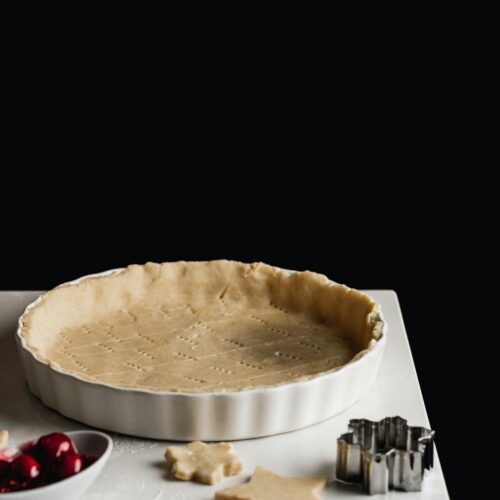
Quick and Easy Gluten Free Pie Crust
Ingredients
- 2 ½ cups Cup 4 Cup gluten-free flour
- ½ teaspoon fine sea salt
- 1 tablespoon sugar
- 2 sticks butter 8 ounces unsalted, good quality butter, cubed
- 1 teaspoon apple cider vinegar
- ⅓ - ½ cup cold water
Instructions
- Combine the gluten-free flour, sea salt, and optional sugar in a food processor and pulse until thoroughly mixed. Sprinkle the cold butter evenly over the flour mixture in the food processor and pulse until the mixture achieves a crumbly texture with noticeable pea-sized butter chunks, crucial for a flaky crust. Drizzle apple cider vinegar over the mixture to enhance flavor.
- Turn on the food processor and immediately start drizzling cold water through the feed tube. Halt the machine once the mixture begins to come together and looks shaggy. Test the dough by pinching it—if it sticks together, it's ready. If not, turn the machine on again and add a bit more water; the goal is a shaggy dough, not a cohesive ball.
- Transfer the dough to a lightly floured surface, shaping it into a ball. Divide the dough into two equal pieces, forming each into a flat disk. Wrap these disks in plastic wrap and refrigerate for at least 30 minutes or up to 2 days. Note that you can freeze the wrapped disks in zip-top freezer bags for up to 3 months, thawing them in the refrigerator overnight before use.
- If the dough has chilled for an extended period, let it sit at room temperature for 10-20 minutes until slightly softened. Roll it out on a parchment paper surface lightly dusted with flour. If the dough cracks upon rolling, give it a few more minutes to warm up. Patch any edges that crack during rolling.
- For a Single Crust Pie, preheat the oven to 400˚F. Transfer the rolled-out dough to a 9-inch pie plate, ensuring it covers the corners. Trim the dough to a ½-inch overhang using kitchen scissors. Fold the overhang under to form a ring around the pie plate, crimping it if desired. If the dough feels soft, refrigerate or freeze the pie plate briefly to firm it up. Prick the bottom with a fork, line the crust with parchment paper, and fill it with dried beans or pie weights. Bake for 15 minutes, remove the parchment and beans, and bake an additional 5 minutes or until lightly golden.
- For a Double Crust Pie, preheat the oven to 400˚F. Roll out one dough disk and transfer it to a 9-inch pie plate. Add your fruit filling and dot with butter. Roll out the second piece of dough and lay it over the filling. Trim the dough to a ½-inch overhang using kitchen scissors. Roll the overhang under, pinching the top and bottom dough together to form a ring around the pie plate. Crimp the ring if desired. If the dough feels soft, briefly refrigerate or freeze the pie to firm it up. Brush the top dough with an egg wash, sprinkle with sugar, cut a few vents, and bake for 35 minutes. Reduce the oven temperature to 350˚F and bake for an additional 15-30 minutes or until the fruit is tender. Tent the top crust or edges if they start to brown too much.
Notes
Tips: Opt for Cup 4 Cup Gluten-Free Flour to achieve an easily rollable dough with the nostalgic taste of a traditional pie crust. Another gluten-free alternative is Bob's Red Mill 1-to-1 Gluten-Free Baking Flour; however, be prepared for a crumblier texture that is better suited for galettes. If gluten isn't a concern, feel free to use any regular all-purpose flour of your choice.
Exercise caution when combining the butter and flour—avoid over-processing to maintain the presence of small butter chunks, ensuring a flaky end result. The dough might appear shaggy and slightly floury in the food processor; resist the temptation to over-process, as this could lead to a tough crust. The dough will come together on the countertop as you shape it into a ball.
If a food processor isn't at your disposal, fear not—you can create this dough by hand. Begin by whisking the dry ingredients in a spacious bowl. Introduce the cold butter cubes, and using your fingers or a pastry cutter, rub the butter into the flour mixture. Toss and smash until incorporated, leaving larger pea-sized chunks visible. Drizzle in the apple cider vinegar and cold water, then toss with a fork until the dough comes together. Proceed to turn it out onto a floured piece of parchment paper as indicated in the recipe.